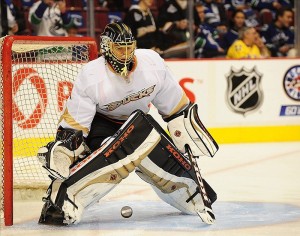The Calgary Flames entered the 2013-14 season with low expectations. Against all odds, by virtue of a strong team concept and a stellar work ethic, the team arguably over-achieved and finished 27th overall, a whopping 15 points ahead of the basement-dwelling Buffalo Sabres and an even 10 points up on the perpetually-rebuilding Edmonton Oilers, their most bitter rival.

As a result, the Flames missed out on the possibility of drafting Aaron Ekblad or Sam Reinhart, instead “settling” for Sam Bennett at 4th overall.
Entering year 2 of their team’s rebuild, it appears that the Flames are attempting to rectify that problem. The club’s off-season moves seem, on the surface, destined to make the team potentially less competitive in 2014-15. Rather than open up roster spots for the team’s rapidly-improving crop of young prospects, the team instead went in the other direction; adding 27-year-olds Brandon Bollig and Devin Setoguchi, 28-year-old Mason Raymond and 32-year-olds Jonas Hiller and Deryk Engelland.
The obvious thought is the Flames are trying to be bad on purpose. After all, the club boasts just three main players that can move the needle in terms of puck possession – Mikael Backlund, Mark Giordano and T.J. Brodie – and just lost their most potent offensive weapon in Mike Cammalleri to free agency and lost two-way and special teams stalwart Lee Stempniak to a late-season trade. With the losses they’ve incurred from last season’s roster, there’s a good chance that the Flames will be (at least) a little bit worse at even-strength, on the power-play and on the penalty-kill.
In short: the gap between the Flames and the NHL’s truly “bad” teams will be smaller than last season.
The veteran-laden roster probably isn’t a result of the team trying to be purposefully bad to gain the services of Connor McDavid or Jack Eichel. Instead, it’s likely more related to the prospect development philosophy touted by Treliving. In an interview with Sportsnet’s Mark Spector, Treliving explained the overriding questions guiding the placement of the team’s developing players.
“There are a lot of guys who can play in the league. But [the real questions are] can you help the team, and is it good for you?” Treliving asks. “I would be shocked [if Bennett sticks]. He will have to come in here and show beyond a shadow of a doubt that, not only is he ready to be here, but this is what’s best for him.”
In other words: when it comes to the development of key pieces of the franchise’s possible resurgence like Johnny Gaudreau, Sam Bennett, Tyler Wotherspoon or Joni Ortio, the overriding development principle may be whether getting NHL playing time on a bad team will be better for their development than playing big minutes or a better team. As a consequence, unless one of players on a two-way contract really blows the doors off of management at training camp, expect to see a veteran-laden squad in Calgary and a lot of young talent suiting up for the American Hockey League’s new Adirondack Flames franchise. Although he hasn’t been as critical as predecessor Jay Feaster regarding the “straight to the NHL” development philosophy in Edmonton over recent years, it seems Treliving is willing to be patient and cautious regarding his team’s future stars rather than rush anybody.
At least for a season or two.
Given the length of the contracts on the books – both signed by Treliving and inherited from the previous regime – the opportunity exists to graduate a goaltender and a handful of forwards for the 2015-16 season and perhaps more for 2016-17. For now, with precious few spots open at the NHL level, Calgary’s top young players will instead begin their pro careers chasing AHL success (for the most part) with the hope of future NHL opportunity located just a bit over the horizon.